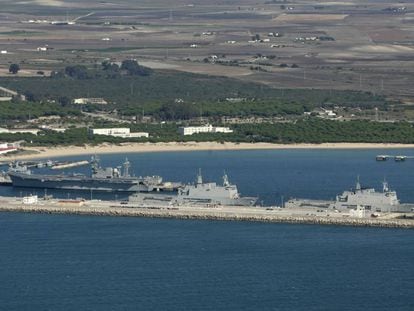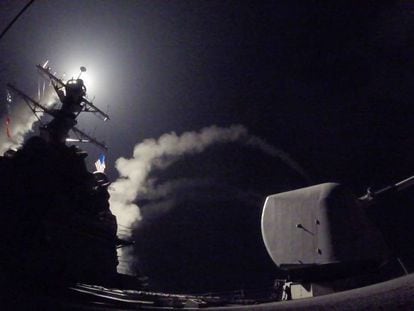America’s shameful rapprochement to the Franco dictatorship
Intelligence cables to which EL PAÍS has had access show that the United States asked Madrid for discretion regarding plans to quietly normalize relations between both countries

On December 6, 1947, the military attaché at the Spanish Embassy in Washington DC sent an encrypted telegram back to Spain’s Central General Staff. The decoded message read as follows: “The current three [in the US Army] received reply to memorandum directed jointly by Army and Navy to State [Department] regarding the need to radically and urgently improve relations with Spain [...]. In the highly secret document, the State [department] says literally: relations with Spain in all their aspects will be normalized quickly without a sound or statements to the press. My informer [...] feels it [would be] convenient for us to follow a similarly discreet policy in outward manifestations during process [of] change.”
It makes sense that the US State Department did not want news to get out about its intention to normalize relations with Spain. Just a year earlier, the United Nations had condemned the regime of Spanish dictator Francisco Franco, turning it into an international pariah. In 1950, President Truman made a public show of dismay at a budget item that included a loan to Spain. “This attitude by Mr Truman is not odd in the least, and can be viewed as the natural continuation of the comedy that he has been acting out since the very first moment,” wrote the attaché in Washington.
The Pentagon saw Spain as a potential ally because of its strategic location and because of its furiously anti-communist sentiment
By then, both countries had already taken some discreet steps. In 1948, Franco gave US military members stationed in Europe and their families permission to enter Spain without a passport. The Cold War was brewing, and the Pentagon saw Spain as a potential ally because of its strategic location and because of its furiously anti-communist sentiment. Very soon, talks began to set up US military bases on Spanish soil.
According to a note by the Central General Staff dated July 28, 1951, the five ports requested by Washington DC were Mahón, Cartagena, Cádiz, Ferrol del Caudillo and Santander. The 1953 agreement finally settled on three air bases (Morón de la Frontera, Torrejón de Ardoz and Zaragoza), one naval base (Rota) and many other minor facilities.


But the presence of US troops was causing suspicion, and a note dated January 1956 echoed “unconfirmed news” that the US might have obtained authorization to keep a nuclear bomb deposit in San Pablo (Seville).
In October 1954, Army Minister Agustín Muñoz-Grandes – Franco’s right-hand man and the ex-chief of the Blue Division, a Spanish unit that served with the German army during WWII – spent two weeks in the US. During his visit, he told his US counterpart, Robert Stevens, that Franco wanted to join NATO but would not apply out of fear of a veto by an Allied member.
In November 1955, US State Secretary Foster Dulles met with Franco in Madrid, where the dictator confessed that if Spain were to join the UN, it would bring up the issue of Gibraltar but accept the British base’s presence. The following month, Spain was admitted into the United Nations. In 1959, US President Dwight Eisenhower visited Spain. Franco’s international isolation was definitely over.
Masons, Jews, Nazis
Obsessed with Freemasonry. In March 1968, the Segunda Bis – a secret unit attached to the Second Section of the Central General Staff – sent the minister a note entitled "Reactivation of masonic activities." The note ended in apocalyptic tones: "The current existing situation in nearly all layers of society and the palpable dissatisfaction in many sectors is clear evidence that what was advocated in 1936, a few days before the beginning of the Movimiento, is being carried out in practice in an undercover but efficient manner." In January 1971, this unit sent a list of Americans who were members of the "Masonic Sect of the Rosicrucian Order" and who owned homes in Spain.
From Melilla to Israel. On July 13, 1955, the Segunda Bis unit warned about the arrival of "three Hebrews" in Melilla whose goal it was to recruit "any Israelites willing to travel to Palestine for free." Legal advisers noted that such activities could constitute a crime against the Spanish state's independence, punishable with jail. A September 9 note, however, adds that "this emigration, apparently sponsored by the State of Israel, does not constitute military recruitment." Informers say that on July 19, a steamboat named Jerusalem left for Palestine carrying 173 migrants, of whom around 16 were natives of Melilla and the Spanish protectorate.
Nazis to South America. A note from the military attaché in Rome, dated December 1949, asserted that "the news regarding a purported organization in Europe with an interest in clandestine emigration of ex-Nazifascists to South America is in part well-founded." The network's key man in Rome, said the note, was one Willy Friede, a former commander of the German army and a librarian at the German-Hungarian School in the Italian capital.
English version by Susana Urra.

